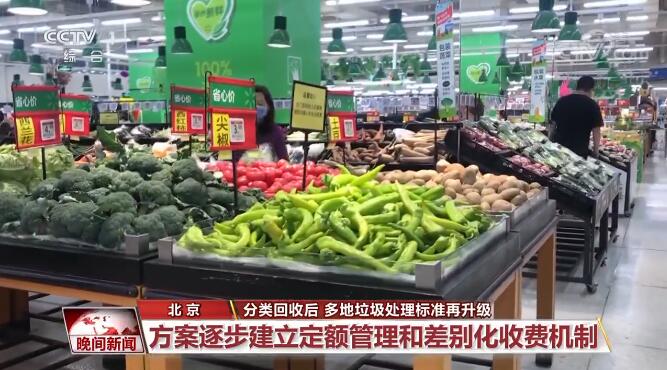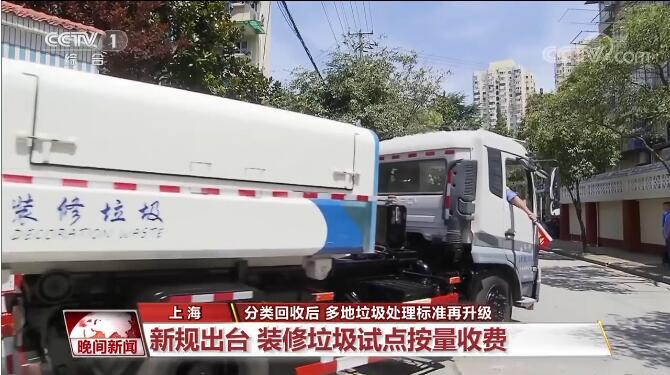CCTV News:Garbage sorting and recycling has been carried out in many cities across the country, and in some cities, the first step of garbage sorting has been completed, and we must try our best to promote garbage reduction and turn garbage into treasure. In the past two days, Beijing, Shanghai and other places have successively upgraded the new scheme of garbage disposal, which has attracted a lot of attention.
Beijing: 300 yuan/ton non-resident kitchen waste charges for comments.

Since July 16th, Beijing has publicly solicited opinions on the measurement and charging standard of non-resident kitchen waste, and the charging standard has been adjusted to 300 yuan/ton, covering about 50% of the garbage transportation and treatment cost. Why does Beijing’s new garbage disposal policy first target non-resident kitchen waste? According to the survey, the water content and impurity content of non-resident kitchen waste in Beijing is about 70%, which not only brings pressure to garbage transportation, but also increases the difficulty of environmental protection treatment in the later stage. Therefore, metering and charging is conducive to reducing kitchen waste from the source.
The scheme gradually establishes quota management and differentiated charging mechanism.
Non-resident kitchen waste should be metered and charged, but it is not enough to create more garbage and pay more. Non-resident kitchen waste mainly includes food residue, food processing waste and other kitchen waste produced by catering service enterprises, unit canteens, farmers’ markets and other units. The new regulations take the unit canteen as the object of first adjustment, and will implement quota management and differentiated charges for collective canteens such as government agencies and institutions.
Quota means that the collective canteen needs to control the total amount of non-resident kitchen waste, while differentiated charging means that the actual garbage output is lower than the quota standard and the price is higher than the quota standard, which reflects the reward and punishment. Less than 50% of the quota standard, according to the 200 yuan/ton; If the actual garbage output exceeds the quota standard, the excess will be collected according to 600 yuan/ton, and differentiated charging will help guide non-resident units to take measures to reduce garbage such as water control and impurity control.
In addition, Beijing’s new garbage disposal policy also gives relevant catering enterprises and unit canteens time to gradually adapt. After the unit collective canteens are fully implemented for a period of time, they will try to implement quota management, and other non-resident units such as catering service enterprises will implement it after the conditions are ripe, which is more flexible and temperature-sensitive.
Shanghai: new regulations are introduced to charge according to the amount of renovation waste.

In Shanghai, a large white box of 6 cubic meters has recently appeared in many communities, which can hold about 5 tons of decoration garbage. Residents nearby can put bagged construction waste into the box by appointment. This is because Shanghai has recently adjusted the collection and transportation management of decoration garbage and bulky garbage. In the past, the cost of cleaning and removal of decoration garbage was generally calculated according to the interior area of the house. After adjustment, six districts in Shanghai, such as Xuhui and Hongkou, will carry out pricing by bag, by box, by car and by piece, and charge by volume and settle by facts. After accounting, the clearing fee per ton will be between 100 and 200 yuan.
Zhejiang: Creating a new model of governance, turning waste into treasure

In addition to reducing the amount of garbage from the source, how to turn it into treasure after the garbage is produced, all parts of the country have also shown their magical powers and adopted various technical means to realize waste reuse.
In Zhejiang, 30 communities in Tongxiang City have already used kitchen waste disposal machines, and put garbage at "fixed time", and the goal of reducing kitchen waste by 20% has been achieved.
Take-away lunch boxes, milk tea coffee cups and hamburger packaging, can these "other garbage" be recycled? Hangzhou West Lake District gives the answer with action. The local "circulating bus" is the first dedicated line for the removal of contaminated paper and plastic domestic garbage in China, which effectively solves the problem that contaminated products cannot enter the recycling channel. The lunch boxes that were originally to be burned were turned into usable paper, plastic granules and aluminum granules after resource treatment.
[edited]
Differential charges force the source of garbage to be reduced; Recycling, turning waste into treasure. There is a consensus in the field of environmental protection, that is, "the so-called garbage is actually misplaced resources". To implement garbage classification, there must be a good concept, a feasible method and a guarantee mechanism to put the misplaced resources back.
关于作者